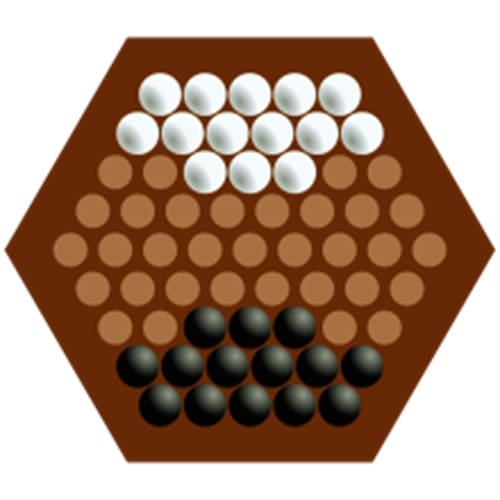
OBJECTIVE OF ABALONE: The aim of Abalone is to be the first player to push six of an opponent’s marbles out of play.
NUMBER OF PLAYERS: 2 Players
MATERIALS: Game board, 14 Black Marbles, 14 White Marbles, and Instructions
TYPE OF GAME: Board game
AUDIENCE: All ages
OVERVIEW OF ABALONE RULES
Abalone is a simple game that was created for two-person gameplay. It involves strategy, defense, and thinking ahead, like checkers and chess. The goal is to remove six of your opponent’s marbles from the board by pushing them with your own. Will you lose your marbles or force someone to lose theirs?
Below, we will go over the standard Abalone rules and some variations.
SETUP

Firstly, you will place the gameboard in the middle of the playing area. Each player will then arrange their marbles; one will take white, and one will take black. You orientate the marbles so that they fill the two back rows and the three spots in the middle of the third row on their side.
Once you arrange the marbles correctly, with all fourteen being on the side of the correct player, the game is ready to begin. Traditionally, in Abalone rules, the player with the black marbles goes first.
HOW TO PLAY ABALONE
During your turn, you may move your marbles one space. You may move a single marble or an entire column of your color. A column may consist of two or three marbles directly adjacent. Marbles may move in an in-line way or a side-step way. You will move all marbles in the same direction if you move a column.
You should always think your turns through. Even though it may seem like a great idea to push your opponent’s marbles off the board every chance you have, you could leave yourself open. For example, if you use two marbles to push one of your opponent’s marbles off, you will leave one of your marbles directly on the edge, easy to push off.
SUMITO
If your column faces another player’s column of lesser marbles, you have the advantage or Sumito. The column containing more marbles may push the other one space. Only three marbles can be moved at one time, regardless of orientation. For Example, if you have in line 3 marbles, but your opponent only has 1 marble in that same line you have the Sumito, or advantage.
Gameplay continues this way, with players taking turns moving their marbles until one player pushes six marbles off the board.
RULES TO REMEMBER
Here are some important Abalone rules to remember while playing.
- You can only move an opponent’s marble if an open space or the board’s edge is in line with the marble.
- Once you push a marble to the rim of the board, it is no longer playable.
- A single marble cannot push an opponent’s marble.
- You can only move up to 3 marbles in a turn.
- If pushing an opponent’s marble you must have more marbles inline than them. For example, if your opponent has one marble 2 or more of your marbles can push it. However, if your opponent has 2 marbles you will need three marbles in line to push them.
- Always keep an eye on your board.
- Do not make moves until you have though of the outcome and where your pieces will be left.
- Try to move your marbles in groups of 2 or 3 at a time. You will be less likely to leave your marbles stranded as singles.
END OF GAME
Whenever you push six marbles off of the board, the game comes to an end. The player that pushes the 6th marble off wins the game!
VARIATIONS
Most variations to the Abalone rules are to add additional players to the game. An example below shows a board that can play up to 6 players.

When you add players, the number of marbles a player has will decrease.
3-PLAYER ABALONE
When you play three-player abalone, each player receives 11 marbles. You will place the marbles the same as standard Abalone without the top 3 marbles. In this variation, you can push two marbles of a different color with 3 of the same color. The first player to push six marbles out (not of their own) wins.
6-PLAYER ABALONE
You get six marbles and place them in a triangle in the center of the starting side of your board. There will be three teams. A player’s teammate sits across from them. The goal and rules remain the same as standard Abalone.
- 12 BEST HARRY POTTER BOARD GAMES - November 16, 2023
- 50 BEST HALLOWEEN GAMES - October 4, 2023
- 50 BEST CHRISTMAS GAMES - September 13, 2023